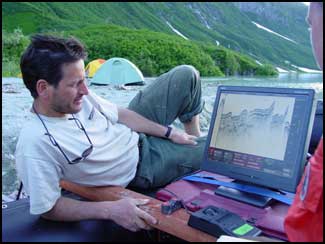The Arctic serves as a barometer of climate change worldwide, and that gauge is telling scientists that things are heating up. Arctic temperatures are warming twice as fast as the global average.
This accelerated warming confirms climate-model predictions that the Arctic amplifies climate change as reflective snow and ice are replaced by heat-absorbing water and vegetated surfaces, according to Northern Arizona University geologist Darrell Kaufman.
“The long-term trend over the past 5,000 years has been toward global cooling, but the Earth is now bucking that trend, which suggests that humans are having a greater impact than some people think,” said Kaufman. “The last time temperatures were as warm as they are now was probably about 8,000 years ago, and we are rapidly on our way to conditions that haven’t been experienced for about 130,000 years, since before the last ice age.”
Interest in this warming trend continues to heat up because geologic archives of past warm intervals show profound environmental changes associated with temperatures just a few degrees higher.
Kaufman leads a team of researchers from 10 universities that is working in Alaska, Canada, Iceland and Greenland to piece together information from the geologic record to determine the causes and consequences of the present record warming. Their five-year project is supported by a $2 million grant from the Arctic System Science Program of the National Science Foundation.
Kaufman, along with his students and colleagues, are collecting sediment cores from 30 lakes across the North American Arctic to decipher how the climate has changed over the last 2,000 years. This period includes the Little Ice Age, roughly 1500-1800 AD, when Earth’s climate experienced significant changes.
To capture this critical time period, Kaufman’s team is relying on sediment layers deposited year by year by glacial melting to reconstruct past climate.
“Lakes are important repositories of information about past climate change,” Kaufman said. “When the climate changes, the environment in and around a lake also changes. These changes can be interpreted from the type of sediment and organic material that accumulate on the lake bottom.” NAU geology graduate student Kasey Kathan has been working with Kaufman in Alaska for the last three years. At Cascade Lake in southwestern Alaska, Kathan pilots an inflatable boat, outfitted with a special coring rig, to collect sediment cores up to 15 feet long from the lake bottom.

Kathan said that the glacier that feeds Cascade Lake has retreated about a quarter of a mile in the last 20 years as the result of warmer temperatures melting the glacial ice. These warmer temperatures also equate to thicker layers of sediment transported into the lake by the glacial melt.”It is very muddy, very wet and sometimes very cold,” Kathan says of her summer research forays to the region.
Kaufman has been studying glacial geology in Alaska for 20 years. His present research focuses on four lakes across southern Alaska because climate is not warming uniformly across this large area. Similar studies in Canada, Greenland and Iceland will help develop a more comprehensive picture of climate change.
“While climate is influenced by many factors, including volcanic activity, solar variability, and ocean currents, there is not enough force in any of those to power the magnitude of climate change we’re seeing at present. Climate is always changing and has a tendency to change rapidly,” Kaufman said, noting that the shifts from full-glacial conditions to a warmer interglacial period have occurred in a matter of decades.
“This means that playing with climate is risky because the system has thresholds and feedbacks we don’t understand.”
“There’s no question that the globe is warming,” said Kaufman. “Our study places the present changes in a longer-term context that extends beyond the Little Ice Age when people first started keeping good records of climate. And we’re learning about what to expect as climate warms by taking advantage of geologic records of previous warm periods.”
More information about this project is at www.arcus.org/synthesis2k/.



